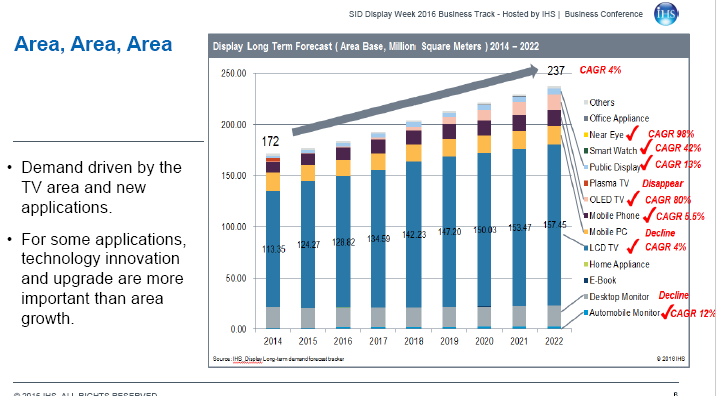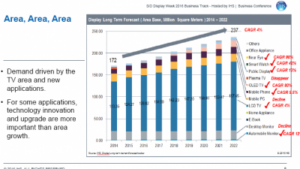The next speaker was David Hsieh, who heads up the Display Research for IHS, and he asked why display innovation is bypassing the PC/IT space? He showed the development of the industry overall and the growth in area consumption of flat panels and it is coming from automotive, TV, public display etc, not in PCs and other traditional IT markets.
 Hsieh highlighted the lack of IT display growth
Hsieh highlighted the lack of IT display growth
There is a big boost in G8 LCD capacity in China as well as developments in G10/11 and a boost in high end G6 LTPS fabs. There is a shift in focus by the Koreans to flexible and rigid OLED. The low end for the Koreans will include oxide transistors, high resolutions, curved and slim. The aim is to also move OLED more to the mainstream.
There is still a long way to go until we have the “wallpaper screen” for TV with very high resolution and brightness. However, HDR and WCG are happening. The industry really needs to understand what customers will really pay for with respect to these features.
Size really matters in TV and the size race continues. Although some people think that the industry might settle on a few ‘sweet spot’ sizes, Hsieh said that this won’t happen, as makers will try to get an advantage from different efficiency and there are differences in their fabs and technology.
Smartphones are also evolving with differentiation. The Samsung OLED in the Galaxy is already probably better than the LCD in the iPhone and that is why Apple may be looking at using OLEDs. Samsung has started to sell OLEDs to Chinese smartphone companies and Hsieh believes that as much as 20% of smartphones in China will be based on OLED this year. The companies will also adopt flexible displays to allow some innovation.
The opportunity is for area growth in output, but the challenge is always in price. There is huge pressure on profitability. The issue is that there is an opposition between profitability of panel and TV set makers. When panel makers are making losses, the TV set makers have profits. Is there a way for the whole supply chain to gain profits, he asked?
Consumers expect end product prices to keep going down and that is making life difficult.
Turning to PC/IT, there could be opportunities for OLED – could it move into PC? The problem is that LCD is good enough for most users and OLED currently has cost and energy disadvantages when showing Windows or other operating systems. There will have be more development (image sticking is still an issue).
 Hsieh presented this chart of LCD vs OLED in IT applications – click for higher resolution
Hsieh presented this chart of LCD vs OLED in IT applications – click for higher resolution
Turning to smartphone, there are rumours of Apple switching to OLED. However in LCD, there were two levels of display quality and performance – one for Apple and another for ‘the rest’. Will Apple have the same difference? Could you combine LTPS with a-si – Apple has a patent – US9129927 – could you put CPU & GPU ino a single chip and get rid of the frame buffer? Innovation may be at the system level rather than just at the display?
Why move to OLED? The technology has good visual performance and an attractive form factor. Flexible is a potentially big issue. Will the consumer appreciate the difference? Is it a must have or a nice to have? It’s not enough to develop it, you have to communicate it. Could a foldable iPad be attractive, eliminating the need for dual devices, Hsieh asked?
Analyst Comment
From my point of view, Hsieh’s question about profitablity was resolved a long time ago. The panel makers and set makers are like the characters on a Swiss weather clock. Only one can be out of the clock at a time. When the woman comes out, the man goes in and vice versa.
It was good to see some attention to the monitor space at this year’s event, in many years it has been very neglected. (BR)

